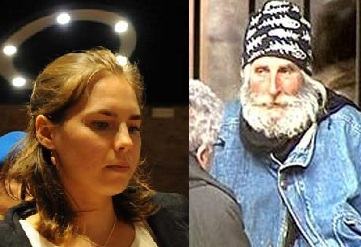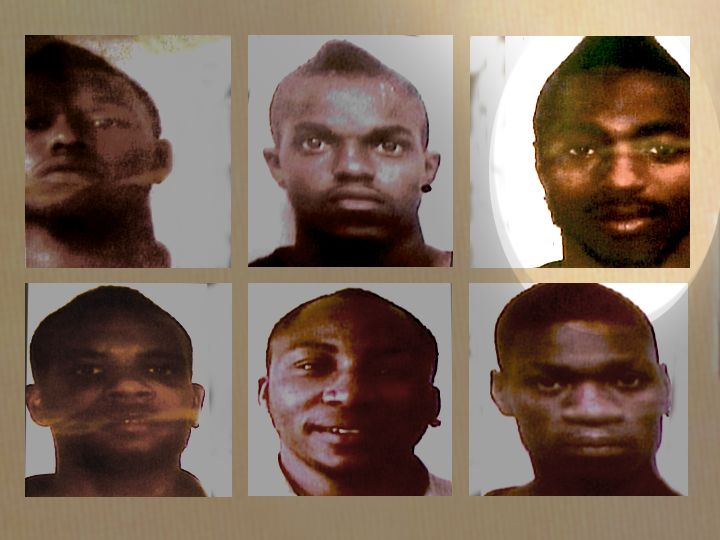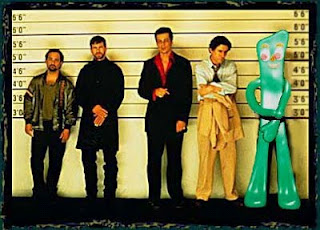We’ve all experienced this scene in theaters, in a book, or on TV: A packed courtroom, a nervous defendant, on trial for murder. The prosecution team sits confidently, convinced they have effectively made their case. As the tension builds, Perry Mason (or fill in your favorite fictional attorney), calls one last witness for the defense. Mason starts speaking to the witness in a friendly tone, but the questions get more and more pointed:
“So, Mrs. Higgenbotham, you were there in the house that night, weren’t you? And you saw who killed Mr. Snodgrass, didn’t you?!!”
Through sobs, the witness screams out, “Yes! Yes! It was HIM!! He did it!” She points to a man in the back of the courtroom. The man’s eyes grow wide, as he realizes all eyes are suddenly on him. He bolts for the door, but is grabbed by the cops who sit at the back of the courtroom. It’s pandemonium as the man is dragged off to jail, since everyone now knows who is actually guilty, and everyone lives happily ever after.
Fast-forward to real life, to real cases, with real, non-fictional people. In real life, the testimony of an eyewitness is one of the most powerful types of evidence against a person. And it is also frequently wrong. Most people, and most jurors, would be very surprised to find out how inaccurate this type of evidence can be.
Since the advent of the use of DNA in forensic science, eyewitness misidentification has become widely recognized as the leading cause of wrongful conviction in the United States, accounting for more wrongful convictions than all other causes combined.
According to the Innocence Project, eyewitness misidentification testimony has been a factor in 72 percent of post-conviction DNA exoneration cases in the U.S. since the advent of DNA testing in 1989. In a substantial number of those cases, the person who had been convicted was identified as the culprit by two or more persons. How can this be? People can remember accurately what they have seen, right? Especially when it comes to something important and/or traumatic, like a murder or other serious crime.
Well, no.
Human memory doesn’t work like a camera, capturing the details of a scene, saving them, and then retrieving them when we need them. Our memories are often distorted by our schemas and other factors. Schemas are things we have learned throughout our lives, and are expectations that our brains have about how the world works, in particular situations. If we can’t recall a piece of information when trying to remember something, our mind will replace it with something else. We automatically “fill in the gaps”, so to speak, with facts that we expect to be there, not with what actually was there. When this happens, memories become skewed. Maybe we saw the person running away, or from a distance. In that case our minds fill in the details that we did not see or don’t remember with the details we think should be there.
We store parts of memories, and reconstruct them later
This is particularly problematic when police or others do things, often inadvertently, to influence what witnesses think and feel. For example, once the police have a suspect in mind, their questions to the witness may be biased, and contain elements of that suspect’s description. The officer might even make hints as to whether the witness is on the right track with their description, and unwittingly be providing positive reinforcement to the witness to fill in their memory in a certain way.
We normally are not asked to remember every little detail of what happened in a particular situation. If a friend asks us, “What did you have for dinner last night?”, it is sufficient to say, “Steak”, or “A burger and french fries”. But remembering precise details is important when a person is a witness to a crime. Even the smallest detail can become extremely important. Was the assailant five feet nine, or five eleven? Was his hair light or dark brown? Did he have a mustache, and how thick or how thin? When people can’t remember these details it is not because they have a bad memory – in reality, that is how most people’s memories work. But the expectation of judges and juries is that people can and do remember such details, and with accuracy. Which is why so many false convictions are based on this type of identification evidence.
In the recent trial of Amanda Knox in Perugia, Italy, Knox spent nearly four years in prison, in part because of how strongly people believe it when another person says they saw, or even heard, something, and are willing to testify to that in court. Knox and her then boyfriend, Raffaele Sollecito, claimed to have been at his apartment all night the evening that Meredith Kercher, Knox’s roommate, was murdered at the cottage they shared across town. There was little to no believable forensic evidence that the two were at the crime scene the night of the murder.
So, to refute their story, the prosecution called a series of “eyewitnesses”, and the public (and first trial jury) accepted that Knox and Sollecito must be guilty of the murder, at least in part because of the testimony of these witnesses. People saw them in places other than where they said they were that night, so they must be lying, and therefore must be guilty, right?
Well, no. The first “eyewitness”, Antonio Curatolo, who claimed he had seen them in an area close to the murder cottage, during the evening when they said they were home at Raffaele’s apartment. Dubbed the “super witness” by the prosecution, Curatolo turned out to be a homeless heroin addict and dealer who gave conflicting testimony at the appeal trial, and had testified in two other murder trials in the past. How many people do you know that have been a witness at multiple murder trials? With their memories being relied upon to convict people, when they admitted using heroin?
Amanda Knox, and the “Super Witness”
Another “eyewitness”, Mr. Quintavalle, who said he had seen Knox the morning after the murder in his shop, when she claimed to be in bed with her boyfriend, was initially believed to be ironclad proof that she must be lying. Except when looked at closer, this identification became much more suspect. When asked in the days immediately after the murder if he had seen Amanda, even when shown her picture, he said, “no”. Then, a year later, when Knox’s picture had been all over TV for months as the prime suspect in the murder, a journalist asked this witness if he had seen her, and suddenly he had a new story, and said he had seen her there the morning after the murder. At this point, the case had become famous, and he had had the opportunity to see Knox’s picture multiple times, both on TV and when shown by the police. None of the other people that worked in the shop saw her. Yet many people, including the judge in the first trial, used this as damning evidence that Knox and Sollecito were lying about where they were that night. If they realized the truth about how unreliable such identifications really are, they might have had a different point of view, or at least looked for supporting evidence, instead of giving so much importance to these witnesses.
Were these witnesses mistaken, or purposely lying? It’s hard to tell, and it doesn’t really matter, because the effect on defendants is the same either way. Yet this question leads us to another reason we have to be more careful about identification evidence: Sometimes, people lie.
On December 5, 2005, Ryan Ferguson, a High School Senior, was found guilty of second-degree murder and first-degree robbery of Kent Heitholt, and was sentenced to 40 years in prison. His conviction was based solely on the testimony of two people, Chuck Erickson and Jerry Trump. Both identified Ferguson as being at the scene of the murder. Ferguson denied being anywhere near the crime scene, and there was not one piece of physical evidence found to link him to the crime.
Ryan Ferguson
Both Erickson and Trump have since given sworn affidavits stating that they were lying. But despite the two now saying they lied, the state of Missouri is still fighting to keep Ryan Ferguson in jail. Do we believe these two when they identified Ferguson the first time, or now, when they say they are lying? Maybe it makes more sense not to have given so much credence to these witnesses in the first place, without any supporting facts to back up what they are saying.
While the two witnesses in the Ryan Ferguson case have admitted they lied when they identified him, sometimes well meaning witnesses and victims are simply mistaken, despite making every effort to get the identification right. In 1984, a young woman named Jennifer Thompson was raped by a stranger who broke into her apartment in the middle of the night. Determined to do everything she could to escape her attacker and bring him to justice, she made a point of studying the man’s face, mannerisms, anything she could so she could identify him later. Even though she was being violated, she bravely took in every detail that she could of her attacker’s appearance so she could, hopefully, keep others from being victimized. Although most of the attack took place in darkness, she felt confident she knew what the attacker looked like, how tall he was, etc.
Jennifer gave a detailed description to police, who made a composite drawing and brought in some suspects. One of those suspects was Ronald Cotton, and she identified him in a lineup as her attacker. Cotton was convicted of the rape and another rape the same night, and sentenced to life plus fifty-four years in prison. Although two terrible crimes had been committed, it seemed that at least the perpetrator had been brought to justice, largely through Jennifer Thompson’s testimony.
If our ability to recall exact details of what we see is ironclad like many think it is, this story might have had a happy ending. But something unexpected happened that would once again change the lives of both Jennifer Thompson and Ronald Cotton forever. While Cotton was appealing his conviction, a man in prison told another inmate that he had committed the rapes of Jennifer and the other woman. But the victims continued to believe their attacker was Cotton, and his appeal failed. However, in 1994 Cotton got new attorneys who requested that DNA testing be done on biological evidence left by the attacker. The DNA did not match Cotton, but did match the DNA profile of the inmate who had earlier confessed to the crimes. Ronald Cotton was finally released from jail, after almost 11 years behind bars.
How could this be? Jennifer Thompson was so sure it was Cotton who attacked her! Even after he was exonerated, with DNA evidence that proved the other man had been her attacker, she still saw Ronald Cotton in her mind as the rapist. What could have happened?
Jennifer had worked carefully with the police to create a composite sketch from her memories of the man who attacked her. After looking at the sketch, she then selected Cotton’s mug shot, which looked a lot like the sketch. Having seen and identified the photograph, she felt sure Cotton was the one when she saw him in person. As the trial progressed, she became more and more convinced this was the man who raped her, the image of Ronald’s face even haunting her in nightmares. By the time she went to court, Jennifer was certain. Her visions of Ronald Cotton as her attacker became so firmly set in her brain that, when shown images of both Cotton and her real attacker, she reaffirmed it was Cotton who attacked her.
Jennifer Thompson, now convinced that she was mistaken in her identification of Ronald Cotton, has become an activist for judicial reform, and speaks out to let people know about the mistakes that can be made when we rely too much on identification evidence. She and Cotton have written a New York Times best selling book, Picking Cotton, challenging people’s perceptions of the ability of a person to identify criminals with certainty. Now friends, they have formed an unlikely alliance, speaking together in public about the case, hoping to tell others about what can happen when we rely solely on memories to decide on a person’s guilt or innocence.
To be mistaken about details we think we have witnessed is not the result of a bad memory, it is because of how our memory actually works. When we want to remember something, we don’t simply pluck a whole memory intact from data kept in storage. The memory we play back is actually built from both stored and available bits of information, then we unconsciously fill in any gaps in the information with inferences. This is fine for most situations, but in a criminal case, where someone’s very life may be on the line, it is not always a reliable indicator of guilt. We need to be sure there is sufficient evidence that supports the story told by the eyewitnesses, and not just rely on their testimony as gospel.
A study on the reliability of identification evidence was done by Patricia Tollestrup, John Turtle, and John Yille, and published in the book, Adult Eyewitness Testimony: Current Trends and Developments, by David F. Ross, J. Don Read, Michael P. Toglia. The study focused on how people pay attention to a certain scene, how we store that information and how we retrieve it later from our memory. They studied cases where the suspect confessed to the crime. These cases had both eyewitness bystanders and eyewitness victims. The bystanders proved to have a more accurate memory of the crime scene than the victims, who were more closely connected to the crime. For example, only 48% of the bystanders and 38% of the victims involved remembered the hair color of the suspect. Of greater significance, both the bystanders and victim eyewitnesses chose the right criminal only 48% of the time in a lineup. This study not only showed how eyewitness testimony can be unreliable, but debunked the idea most people have that the victim of the crime, having been closest to and most focused on the situation, will remember all the details most clearly. What actually occurs is that the memories of the victims of crimes are often not precise, because they are affected by stress, fear, distractions, trying to escape, etc. This is another reason why identification evidence should not be given as much weight in trials as it is currently.
Another issue that affects identifications is called cross-racial identification. Studies have shown that people have a more difficult time identifying someone of a race other than their own. For example, a black witness will have a harder time differentiating between white suspects, whereas whites will have a more difficult time differentiating between Asians or Hispanics. While the old racist adage, “they all look alike” is not true, what is true is that people are often less accurate when identifying someone of a different race.
A lineup. Which one was he again?
Another issue is the suggestions, advertent or inadvertent, by police when questioning witnesses or conducting lineups. Suppose that a crime occurs, and the police arrive at the scene and start questioning witnesses. They might ask, “What did the assailant look like?” After the witness tells the police what he or she can remember, they may be asked to come to the police station to look at a set of photographs, or called in, perhaps a day or two later, to look at a lineup of possible suspects. In each case, the witness will be asked if any of the people they are looking at is the person that committed the crime. These witnesses are likely to very much want to help the police find the culprit, especially if this was a violent crime. They are also likely to believe, as most people do, that the police would not be conducting a line up unless they had a good idea of who the guilty person is. Although witnesses try hard to get the identification right, when they are uncertain–or when no one person in the lineup matches their memory exactly –they will often identify the person who comes closest to matching their recollection of the criminal, or what they have been led to believe the criminal looked like.
Far too often, their choice is wrong.
Part of the problem of mistaken identifications lies in the fact that many police agencies do not have standardized policies for conducting live and photo lineups that are based on best practices. Most law enforcement agencies use the same methods they have used for decades, and many of these methods result in too many inaccurate identifications. A great deal of these mistakes would be preventable if proper protocols were used.
One key is having a blind administrator conduct the lineup (someone who does not know what the actual suspect looks like, so as to not influence the witnesses). The way the suspects in the lineup are composed is also crucial. “Fillers” (the non-suspects included in a lineup) should resemble the eyewitness’ description of the perpetrator. The suspect should not stand out (for example, he should not be the only member of his race in the lineup, or the only one with facial hair). Eyewitnesses should not view multiple lineups with the same suspect. The person viewing a lineup should be told that it is possible that the guilty person may not be in the lineup, and that the investigation will continue regardless of if they identify anyone, or not. They should also be told not to look to the administrator for guidance.
No one in a lineup should stand out as clearly different from the others.
Believe it or not, lineups have been conducted where the suspect was the only black person in the lineup, or the only woman, or the only man with a mustache! “Gee, which person am I supposed to pick?” This seems absurd, but people have actually been arrested and tried based on being IDed in such a lineup.
One of the most dangerous parts of relying on identification as the sole evidence against a person, is how certain witnesses become once they have made identification. The same memory processes that make many identifications unreliable make people totally convinced after they have identified a suspect. Once witnesses state facts in a particular way or identify a particular person as the perpetrator, they are unwilling or even unable—due to the reconstruction of their memory—to reconsider their story. When a witness identifies a person in a line-up, he is likely to identify that same person in later line-ups, even when the person identified is not the perpetrator. Although juries give great weight to eyewitness identification, many are unaware of the danger of how unreliable this testimony really is.
Several US states, including Texas and New Jersey, have recently pursued legislation to reform the way law enforcement officials gather and use eyewitness identification evidence. Hopefully, more and more people are starting to get the message that convicting people of serious crimes based only on testimony from so called “eyewitnesses” is a practice that must be changed. The idea that, just because someone says they saw someone commit a crime, that it must be true, is a fallacy, and that is proven by research. If over 70 percent of the false confessions corrected by DNA evidence were the result of eyewitness identifications that turned out to be false, changing our reliance on such identifications by themselves can go a long way to reduce the number of unjust convictions in society. Which will not only reduce the number of people unjustly incarcerated, but will allow the police to pursue, and hopefully arrest, the actual criminals, and get them off the streets.
In 1980, Cornelius Dupree was convicted of aggravated robbery in a carjacking and rape case and sentenced to 75 years in prison for aggravated robbery. Even though he did not resemble the original witness descriptions, he was put into a lineup by police, and the victim identified him. After 30 years in a Texas prison, The Innocence Project was able to prove, through DNA evidence, that he was wrongfully convicted of the crime.
“I was a fan of Perry Mason as a kid,” said Dupree, “When you get caught up in the system, you kinda find out it’s a little different.” Maybe justice systems worldwide can start to be a little different too.
 Wrongful Conviction News an Injustice anywhere website
Wrongful Conviction News an Injustice anywhere website





